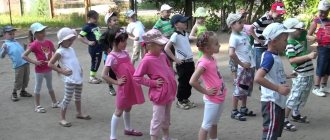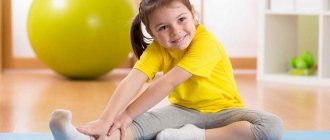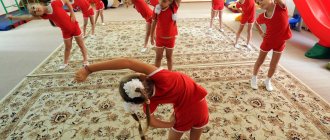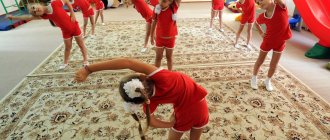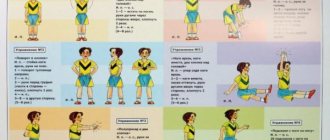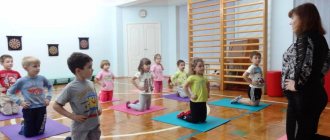Non-traditional forms of morning exercises in preschool educational institutions.
"Non-traditional forms of holding
morning exercises at preschool educational institutions"
The preschool period is the time when the foundation of physical, mental and moral health is laid. Among the many factors that influence the health and development of children, physical education occupies a special place in terms of intensity. In introducing children to a healthy lifestyle, their mastery of the basics of hygienic and physical education is of particular importance. The task of physical education of preschoolers is to form in them a stable habit of systematic physical exercise. Morning exercises play an important role in solving this problem. Although morning exercises in preschool educational institutions are short in time, they compensate for up to 5% of the daily volume of physical activity of children and are considered as an important element of the motor regime. Doing a set of morning exercises every day is the minimum physical activity that should become an element of every child’s personal physical culture. The special place of morning exercises in the daily routine is due to the important role that the transition from sleep to wakefulness, from rest to active activity plays in a person’s daily biological rhythm.
Analysis of previous work, the results of surveys and observations led to the conclusion that it is necessary to model morning exercises of a new type. Currently, many new methods of performing gymnastics have appeared. In order to increase children's interest in exercise, kindergarten teachers introduced non-traditional forms of morning exercises, such as:
— game stretching;
— step aerobics;
- gymnastics on fitballs.
Game stretching (application No. 3)
Game stretching
– these are specially selected muscle stretching exercises performed with children in a playful way. In other words, this is a creative activity in which children live in a world of images, often no less real to them than the surrounding reality.
The implementation of gaming opportunities for the health and development of the child is the essence of gaming stretching. Moreover, all classes are conducted in the form of a role-playing or thematic game, consisting of interrelated situations, tasks and exercises.
The method of play stretching is based on static stretching of the muscles of the body and the joint-ligamentous apparatus of the arms, legs, and spine, which allows one to prevent and correct postural disorders and have a profound healing effect on the entire body.
Exercises are performed without outside influence, because The human body is its own trainer. Self-manipulation of the body in a slow, and therefore safe, rhythm is most effective. In children, complexes associated with the physical imperfection of the body and the inability to control it disappear. In addition, children acquire a reserve of motor skills that allow them to feel strong, beautiful, self-confident, and create a sense of inner freedom.
Non-traditional forms of morning exercises
Nevolina Natalya
Non-traditional forms of morning exercises
“I’m not afraid to repeat again and again: taking care of health is
the most important work of a teacher. From cheerfulness, body-
The growth of children depends on their spiritual life, worldview,
mental development, strength of knowledge, self-confidence.”
V. A Sukhomlinsky.
In the federal state educational standards for the structure of the basic general education program of preschool education as the main task solved within the framework of the direction “Physical Development”
,
the formation of children's interest and value attitude towards physical education is highlighted. Each of the forms of physical education used in preschool educational institutions has its own specific purpose. The physical development of preschool children should be carried out not only in the process of specific physical education and sports games, exercises and activities, but also in the organization of all types of children's activities through physical education, morning
exercises, etc. Every day in kindergarten begins with morning exercises , which has great health and educational significance. It is morning exercises that charge you with energy for the whole day. Teachers need to take a creative approach to organizing morning exercises , include sayings, chants, counting rhymes, music at different tempos, outdoor games, and a variety of sports equipment in classes.
During morning exercises , the tasks of physical, mental, moral, aesthetic and labor education are solved, are formed , speed, agility, strength, endurance, flexibility are developed, and health is strengthened.
The use of traditional methods of organizing children's motor activity, forms of conducting classes and morning exercises , and traditional equipment does not provide the necessary effectiveness of this area of work. The pupils' interest in classes fades, they refuse to do morning exercises .
morning exercise complexes of various types have been developed in kindergartens : built on games and play exercises, using non-traditional equipment , exercise machines, rhythms, play stretching, breathing , etc. Everything is aimed at ensuring that morning exercises make preschoolers want to engage in physical exercise, participate in outdoor games, improve their movements, and show perseverance, courage, and determination.
Non-traditional morning exercises not only preserves and strengthens the health of children, ensures their full physical development, creates interest in physical education and sports, but also supports the positive emotional state of each pupil.
When working with children of primary preschool age, mainly playful, plot-based and combined forms of morning exercises . The game - gymnastics captivates children , their physical development occurs indirectly in the process of entertaining activities. In older preschool age, gymnastics is carried out in the form of circuit training , on simulators using play stretching and rhythm exercises.
Non-traditional forms of gymnastics are designed for all age groups.
Thematic morning exercises are based on playing out a plot, for example: “In the forest”
,
“At the Circus”
,
“Ah, Africa!”
,
“Forest animals”
,
“Schoolchildren”
.
In such complexes, plot-based general developmental exercises are selected, united by one storyline. Cyclic exercises for the introductory part of morning exercises are imitative in nature and convey the actions of the hero in accordance with the plot.
morning exercises based on outdoor games of varying intensity and with different educational objectives. In the introductory part - one outdoor game each ( “Traps”
,
“Whose team will get together sooner”
,
“Catch up with your pair”
).
In the main one, is played , aimed at improving various types of basic movements ( "Cat and Mice"
,
"Wolf in the Moat"
,
"Sly Fox"
).
In the final part of the morning exercises, a low-intensity game is planned to restore breathing and bring all functional systems of the body back to normal.
Combined morning gymnastics includes active and round dance games, dance and rhythmic movements, game stretching exercises, outdoor switchgear, etc. Such complexes, as a rule, have the nature of final, generalizing and completing the work of a certain period.
Rhythmic gymnastics is based on a set of adapted exercises, dance movements, and play stretching exercises. Its complex contains a warm-up consisting of cyclic movements, a series of dance movements or round dances familiar to children. The load on the child’s body in such exercises is very high, since he simultaneously performs two accompanying movements, for example, raising his arms and doing a half-squat, or tilting his head to the side and taking a step forward. Morning rhythmic gymnastics carries a great physical and emotional load, performed with music and is very popular with children.
Morning gymnastics on simulators is a set of introductory exercises and exercises performed on children's simulators. The introductory part is planned as a lead-in exercise to work on a specific simulator. For example, warming up the muscles of the legs and ankle joint will be a preparatory exercise for working on an exercise bike. For this type of morning exercises, it is important to choose the right forms for organizing children’s activities and provide a sufficient number of exercise equipment for the entire group.
Morning exercises using non-traditional equipment . These are well-known outdoor educational equipment for children, which are carried out with non-traditional equipment made by the hands of teachers (plastic bottles, plastic bottles with various types of fillers, expanders made from Kinder Surprise cases, etc.).
Morning exercises in the form of a health jog are carried out mainly in the warm season and include “sports”
(fast)
walking, health-improving, slow running and running with acceleration.
At the same time, the teacher gradually increases the distance, intensity, time, and selects tasks that need to be completed along the way. When carrying out such gymnastics, it is important to correctly dose physical activity, taking into account the age and individual characteristics of the child.
Morning exercises - circuit training is based mainly on cyclic and basic types of movements. The preschooler completes tasks, moving in a circle, from one station to another. This type of gymnastics requires a high level of independence from the child and is carried out mainly in older preschool age.
Morning exercises using task cards, or “independent”
— the final
form of work for a certain period of time by the children themselves. It is carried out using cards with symbolic drawings of certain exercises.
" Multi-gymnastics "
- a set of exercises, which is recorded in
video format as a selection of cartoons, including the movements of cartoon characters to music.
Its complexes can be based on video recordings of exercises performed by children from a given age group and supplemented with various special effects. All of the listed forms of morning exercises are very popular among children. They successfully solve the assigned tasks - to form an interest and value attitude towards physical education.
Morning exercises should become a necessity not only for every kindergarten student, but for every member of the preschooler’s family. As a rule, children in preschool educational institutions willingly do exercises because doing it all together is fun and interesting. Of course, it is more difficult to create such conditions at home, but you definitely need to find an approach to the baby, set him up for the fact that gymnastics needs to be done every day.
The teaching staff does a lot of work with parents, explains the importance of morning exercises , and advises on how to organize it at home. This happens at parent meetings, “demonstration performances”
children, consultations with teachers, methodologists, managers, doctors, music directors, in individual conversations.
Teachers set up special “Parents Corners”
where they post articles about
morning exercises .
From early childhood, it is necessary to form the habit of doing morning exercises . And the personal example of parents is a great force in raising children. Therefore, in those families where adults do morning exercises , the child gets used to the correct daily routine from an early age. The joint efforts of preschool educational institutions workers and parents, the unity of requirements for the organization and conduct of gymnastics will contribute to the development of children’s motor activity and the strengthening of their health.
Literature:
Babina K. S. Complexes of morning exercises in kindergarten . M., 1978.
Leskova G.L., Butsinskaya P.P., Vasyukova V.I., General developmental exercises in kindergarten. M., 1981
Osokina T.I., Physical education in kindergarten. M. 1986
Osokina T. I., Timofeeva E. A. Gymnastics in kindergarten . M., 1969
Complex of morning exercises in the middle group “Snake and I are good friends!”
Complex of morning exercises using non-traditional equipment
“Snake and I are good friends!”
Fomina Victoria Vladimirovna
teacher
Name of the morning exercise complex:
“Snake and I are good friends!”
Age group:
middle group
Petrozavodsk urban district.
2017
A complex of morning exercises for the middle group.
“Snake and I are good friends!”
Equipment:
“hemp” (circles made of thick cardboard), “snakes” (green caps collected on a thread), tape recorder, recording the sound of a snake hissing, a cheerful musical composition.
Motivation of children:
- audio recording of snake hissing
- funny poem
- interesting non-traditional manual (“snakes”, “hemps”)
- the names of the exercises cover one topic
- low mobility game “A snake walked across the field”
- cheerful musical accompaniment
Introductory part:
Between the green grass,
Between old stumps, leaves and mushrooms,
Crawled, hissing into the bushes
The snake is a long string.
Walking in a column. Easy running. Walking like a snake, going around the “stumps”.
Children go around the “stumps”, at this time
The teacher turns on the sounds of a snake hissing and asks: “Who is that hissing?” (Children answer “snake”)
Main part:
- “Hello, snake!”
. I. p. - feet shoulder-width apart, hands folded behind the back. Take a breath. Lean forward. Exhale. Return to starting position. (1 - 2 times)
- “Pick up the snake.”
I. p. - stand with legs apart, “snake” at the bottom. 1 — lift the “snake” forward; 2 - up; 3 - forward; 4 - return to the starting position (5-6 times).
- “Put the snake down.”
I. p.: feet shoulder-width apart, “snake” below. Lean forward, lowering the “snake”, return to the starting position (5-6 times).
- “Show me the snake.”
I. p. - stand with feet shoulder-width apart, “snake” at the bottom. 1 — lift the “snake” forward; 2 - sit down, arms straight; 3 - stand up, “snake” forward; 4 - return to the starting position (5-6 times).
- "Jump over the snake."
I. p. - stand with legs slightly apart, arms at random, “snake” on the floor. Jumping on two legs over a snake. (5-6 times)
- Low mobility game “A snake walked across the field”
The “snake” walks in front of the players with the words: “The snake walked across the field and dropped its tail, (approaches one
of the players)
and then found it”
(touches the child’s “tail”).
The player must crawl between the legs of the “snake” and become its “tail”. And so on until all the children of the “tails” are collected.
Children take "snakes"
stand in a circle.
The “snakes” are placed on the stumps.
According to the counting rhyme, the driver is selected as a “snake”, and the rest of the guys are “tails” of the snake.
Final part:
Goodbye, snake! Crawl away quickly!
Your children are waiting for you
That's a loud name!
All the children, linked to each other (a long snake), walk around the hall. A short walk.
Breathing exercise
“We hiss like snakes”
Children say “sh – sh – sh – sh...”
The teacher turns on cheerful music.
Bibliography:
- FROM BIRTH TO SCHOOL. Basic educational program of preschool education / Ed. N.E, Veraksy, T.S. Komarova, M.A. Vasilyeva. – M.: MOSAIC-SYNTHESIS,
2015. - 368 p.
Photos of visual aids that were used during morning exercises.

